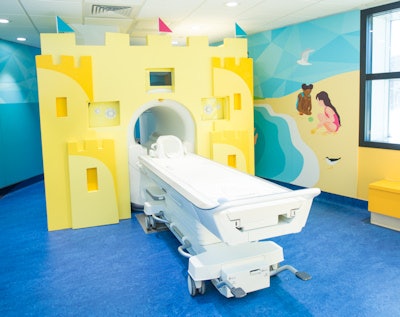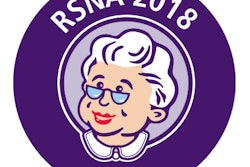
Winter in New England never looked so good as it does inside Yale New Haven Children's Hospital's new pediatric MRI suite, during these cold, snowy days. The facility began imaging children in January in the new beach-themed Scan-Castle, featuring a seascape painted on the wall and blue waves on the tiled floor.
 Dr. Rob Goodman from Yale New Haven Hospital.
Dr. Rob Goodman from Yale New Haven Hospital.The children's hospital invested $6 million to design and build the new pediatric MRI suite to create an environment where kids and their parents feel more relaxed before and during MRI scans. After opening in January, the suite is scanning close to capacity, having imaged 210 pediatric patients in the first 28 days of operation.
"Given that MRI was becoming such an important component in pediatric healthcare, the children really deserve their own dedicated pediatric scanner," said Dr. Rob Goodman, interim chair of radiology and chief of pediatric radiology at Yale New Haven Hospital (YNHH). The scanner is the first MRI system dedicated solely to pediatric patients in the state of Connecticut.
Privacy, please
The children's hospital is bolted to YNHH's academic facility. Until last month, the two hospitals shared various services, such as the MRI scanners, which imaged both adults and pediatric patients in the same suites.
"Adults are not particularly keen on seeing children and children are not particularly keen on seeing adults in the same suite," Goodman said. "So we wanted to make MRI scanning as effortless and as pleasant as possible for our pediatric patients."
The children's hospital chose a 3-tesla MRI scanner (Magnetom Skyra, Siemens Healthcare) for the Scan-Castle, which handles full-body, musculoskeletal, cardiac, and neuro imaging among its clinical applications.
The YNHH initiative is similar to the pediatric-friendly program developed by Weill Cornell Medical College, NewYork-Presbyterian Hospital, and Siemens, which uses superheroes to help young patients get through their MRI scans.
After much discussion, rather than going with cartoon characters, the hospital decided on "something that was age-neutral; something that would appeal to a child, as well as a 15- or 16-year-old patient," Goodman added.
"The beach theme was just perfect to create a relaxing environment," he said. "It is something children look forward to -- going to the beach. We really did push the envelope to make the MRI scanner look like a sand castle."
 The Scan-Castle and MRI suite are designed to comfort pediatric patients and help them relax during their scan. Image courtesy of Yale New Haven Children's Hospital.
The Scan-Castle and MRI suite are designed to comfort pediatric patients and help them relax during their scan. Image courtesy of Yale New Haven Children's Hospital.To help recreate an ocean-side ambiance, parents sit in beach chairs while they wait for children to finish their scans, and the kids get beach balls or other beach toys at the end of the exams.
Pediatric patients also have access to specially designed, MRI-friendly goggles from Cinemavision, which they can use to watch movies or other DVDs during the scan. The goggles make it appear to patients as if they are sitting in a movie theater with the screen some 30 ft away, rather than lying in an MRI tube with the surface just inches from their nose.
Through the goggles, parents can talk to children and children can see parents on the screen talking to them. "But usually it is more fun to watch 'Frozen' or 'Finding Nemo' on a DVD," Goodman said. "The kids are filled with delight for hours."
The children's hospital chose Cinemavision's technology because it was so successful with adult patients.
"Sometimes adults are claustrophobic and have to be sedated, too," Goodman said. "We left the adult pair of the goggles with the adults. They would not let them go, so we have another pair for the pediatric scanner."
The ocean effect
Goodman explained that "the sky is the limit" for amenities.
"We can hang [imitation] seagulls from the ceiling and even have the smell of coconut oil, if we want to, to create that relaxing environment," he said.
The hospital also has child life specialists who work with the young patients and their parents in a child-friendly room with toys before the MRI scan. There is also a small model of an MRI scanner in a different room, which shows patients what to expect during the exam.
This all-encompassing environment of tranquility and fun has serious clinical implications. If the pediatric patients are calm and less fidgety, MR images are better and there is no need for sedation.
So far, the hospital has only anecdotal evidence that the use of sedation has decreased since the Scan-Castle was created. Goodman and colleagues plan to investigate the rate of sedation as more pediatric patients are scanned.
To accommodate the Scan-Castle, the hospital's radiologists gave up their office space. "Our physician offices are where the scanner is now," Goodman said.
As part of a second phase of improvements for pediatric patients, the hospital plans to create a relaxation area where children can recover after surgery or anesthesia.
"We want to create this 'relaxation suite' where all the recovery will be done in a child-centered environment," Goodman said. "That would increase throughput, increase efficiency, and enhance the patient's experience. We hope it would have a beach theme as well, to continue in that environment."



.fFmgij6Hin.png?auto=compress%2Cformat&fit=crop&h=100&q=70&w=100)




.fFmgij6Hin.png?auto=compress%2Cformat&fit=crop&h=167&q=70&w=250)











